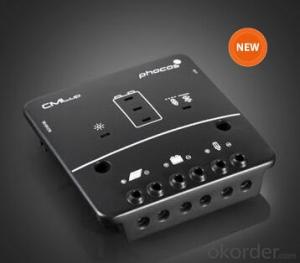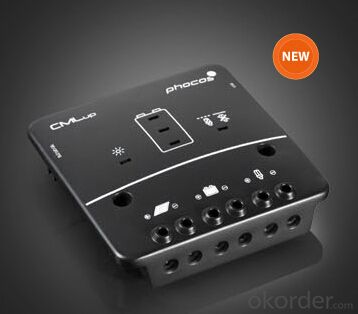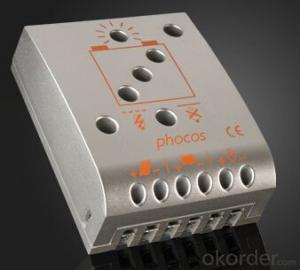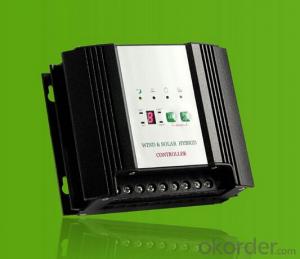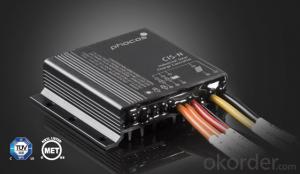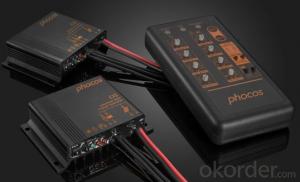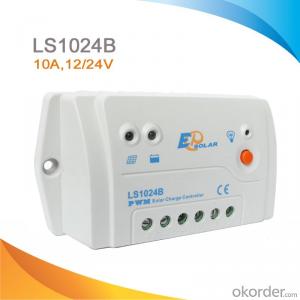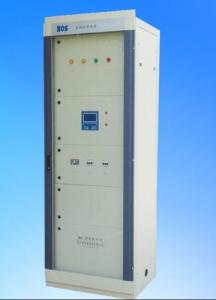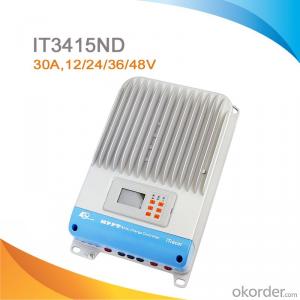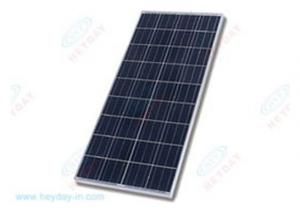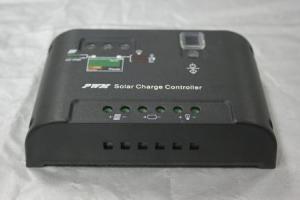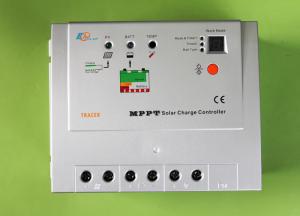50Watt CMLup Series (10 – 20 A) Solar Charge Controllers with Mobile Phone Charging Capability
- Loading Port:
- China Main Port
- Payment Terms:
- TT OR LC
- Min Order Qty:
- -
- Supply Capability:
- 10000 unit/month
OKorder Service Pledge
OKorder Financial Service
You Might Also Like
· SMD assembly, greater reliability
· New housing design
· High current rated MOSFETs
· High performance micro controller
· More intuitive LED design
· USB port for charging mobile phones or small music players
· Easily accessible terminals
· Easy mounting
· The CMLup series of charge controllers are equipped with a number of outstanding features such as a status display, alarm, and safety functions.
· The temperature-compensated, four-stage PWM charging algorithm
· (float-main-boost-equalization) is adjustable for sealed and vented lead-acid batteries.
· The CMLup charge controller also allows either a SOC or voltage-controlled low-voltage disconnect.
· Battery status is clearly indicated by three LEDs. An acoustic alarm warns about an impending low-voltage disconnect (LVD).
- Q: Can a solar controller be used in a commercial solar power system?
- Yes, a solar controller can be used in a commercial solar power system. A solar controller, also known as a charge controller, is an essential component in any solar power system. Its primary function is to regulate and control the flow of electric current from the solar panels to the batteries or the power grid. In a commercial solar power system, the solar controller plays a crucial role in ensuring the optimal performance and efficiency of the system. It helps prevent overcharging of the batteries, which can lead to damage and reduced lifespan. Additionally, it prevents reverse current flow from the batteries to the solar panels during periods of low or no sunlight. By effectively managing the charging process, a solar controller maximizes the energy harvested from the solar panels and ensures that it is stored efficiently for later use. This is particularly important in commercial solar power systems where a significant amount of energy is generated and stored. Furthermore, some advanced solar controllers have additional features such as monitoring the system's performance, allowing remote monitoring and control, and providing protection against overvoltage, short-circuiting, and overheating. Overall, a solar controller is an indispensable component in a commercial solar power system as it helps optimize energy production and storage while ensuring the longevity of the system's batteries.
- Q: Can a solar controller be used with solar-powered pumps?
- Yes, a solar controller can be used with solar-powered pumps. A solar controller helps regulate and optimize the power output from solar panels, ensuring that the energy generated is efficiently used by the pump. It helps manage the charging and discharging of batteries, protects against overcharging or over-discharging, and can provide additional monitoring and control features for the system.
- Q: What is the charging current rating of a solar controller?
- The charging current rating of a solar controller is the maximum amount of current it can handle while charging the batteries from the solar panels.
- Q: Can a solar controller be used with different types of solar panel snow removal systems?
- Yes, a solar controller can be used with different types of solar panel snow removal systems. The solar controller regulates the charging and discharging of the batteries in the system, and it can be configured to work with various snow removal methods such as heated wires, brushes, or automated tilting systems. The controller ensures that the snow removal system operates efficiently and effectively, regardless of the specific type of system being used.
- Q: The controller has a water setting thawing no other settings inside the regular thawing temperature constant water level
- The above heating of the controller is in the absence of the sun and you need to use hot water to add, so that you can use hot and cold weather.
- Q: What is the lifespan of a solar controller?
- The lifespan of a solar controller can vary depending on various factors such as the quality of the controller, usage patterns, and environmental conditions. However, on average, a well-maintained and properly installed solar controller can last anywhere between 5 to 15 years.
- Q: Can a solar controller be used with solar panels that are connected to a solar tracker?
- Yes, a solar controller can be used with solar panels that are connected to a solar tracker. A solar tracker is a device that automatically positions the solar panels to track the movement of the sun throughout the day, maximizing their exposure to sunlight. The solar controller, on the other hand, is responsible for regulating the flow of electricity from the solar panels to the battery bank or the grid. When solar panels are connected to a solar tracker, they constantly adjust their position to capture the most sunlight, which can lead to fluctuations in the voltage and current output. A solar controller helps manage these fluctuations by monitoring the electrical parameters and adjusting the charging process accordingly. It ensures that the solar panels are charging the battery efficiently and prevents overcharging or undercharging. Therefore, a solar controller is essential in ensuring the proper functioning and optimization of solar panels that are connected to a solar tracker. It helps maintain the overall performance and longevity of the solar system by regulating the charging process, protecting the battery, and providing important data on the solar system's performance.
- Q: How does a solar controller handle power fluctuations from the solar panels?
- A solar controller handles power fluctuations from the solar panels by regulating the amount of power that flows into the battery bank. It constantly monitors the voltage and current from the solar panels and adjusts the charging process accordingly. When there is a surge in power, the controller limits the amount of power going into the battery to prevent overcharging. Similarly, during low power periods, it boosts the charging current to ensure efficient charging. Overall, the solar controller acts as a mediator between the solar panels and the battery, maintaining a stable and optimal charging process.
- Q: How does a solar controller prevent voltage drops in the system?
- A solar controller prevents voltage drops in the system by regulating the flow of electricity from the solar panels to the battery. It ensures that the voltage remains constant and optimal by monitoring and adjusting the charging process. This helps to prevent overcharging or undercharging of the battery, which can lead to voltage drops and affect the overall performance of the system.
- Q: What are the advantages and disadvantages of an MPPT solar controller?
- Advantages of an MPPT (Maximum Power Point Tracking) solar controller: 1. Increased Efficiency: MPPT controllers can improve the overall efficiency of a solar system by up to 30%. They track the maximum power point of the solar panels and adjust the voltage and current to ensure that the panels are operating at their optimal efficiency, even under varying weather conditions. 2. Better Performance in Low Light Conditions: MPPT controllers are designed to extract maximum power from the solar panels, even in low light conditions. This means that they can generate electricity even when the sunlight is not at its peak, making them ideal for areas with frequent cloud cover or shading. 3. Compatibility with Different Solar Panel Configurations: MPPT controllers can be used with a wide range of solar panel configurations, including both high and low voltage panels. This makes them highly versatile and suitable for various system setups. 4. Ability to Charge Different Battery Types: MPPT controllers are capable of charging different types of batteries, such as lead-acid, lithium-ion, or gel batteries. They have built-in algorithms that optimize the charging process for each specific battery type, ensuring maximum battery life and performance. Disadvantages of an MPPT solar controller: 1. Higher Cost: MPPT controllers are generally more expensive compared to PWM (Pulse Width Modulation) controllers, which are a simpler and cheaper alternative. The additional features and advanced technology of MPPT controllers contribute to their higher price point. 2. Complex Installation and Setup: MPPT controllers require more complex installation and setup compared to PWM controllers. They often require additional wiring and configurations to connect the solar panels, batteries, and load. This may require professional assistance or a good understanding of electrical systems. 3. Increased Maintenance Requirements: MPPT controllers are more sophisticated devices, and as such, they may require more maintenance compared to PWM controllers. Regular monitoring and occasional firmware updates may be necessary to ensure optimal performance. 4. Potential for Overheating: MPPT controllers can generate more heat during operation due to their advanced circuitry. This heat needs to be dissipated effectively to prevent damage to the controller or reduce its lifespan. Adequate ventilation and proper installation are essential to avoid overheating issues. Overall, the advantages of an MPPT solar controller, such as increased efficiency, better performance in low light conditions, compatibility with different panel configurations, and the ability to charge various battery types, often outweigh the disadvantages. However, the higher cost, complex installation, increased maintenance requirements, and potential for overheating should be considered when making a decision.
Send your message to us
50Watt CMLup Series (10 – 20 A) Solar Charge Controllers with Mobile Phone Charging Capability
- Loading Port:
- China Main Port
- Payment Terms:
- TT OR LC
- Min Order Qty:
- -
- Supply Capability:
- 10000 unit/month
OKorder Service Pledge
OKorder Financial Service
Similar products
Hot products
Hot Searches
Related keywords
